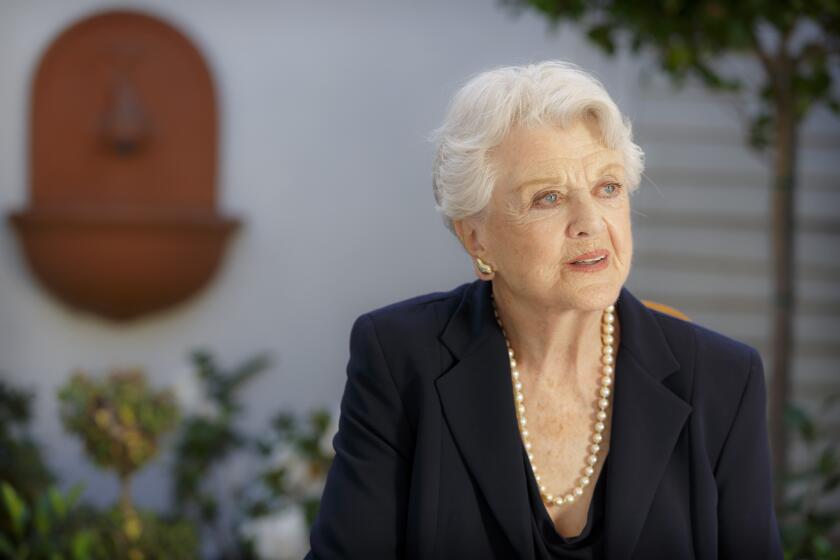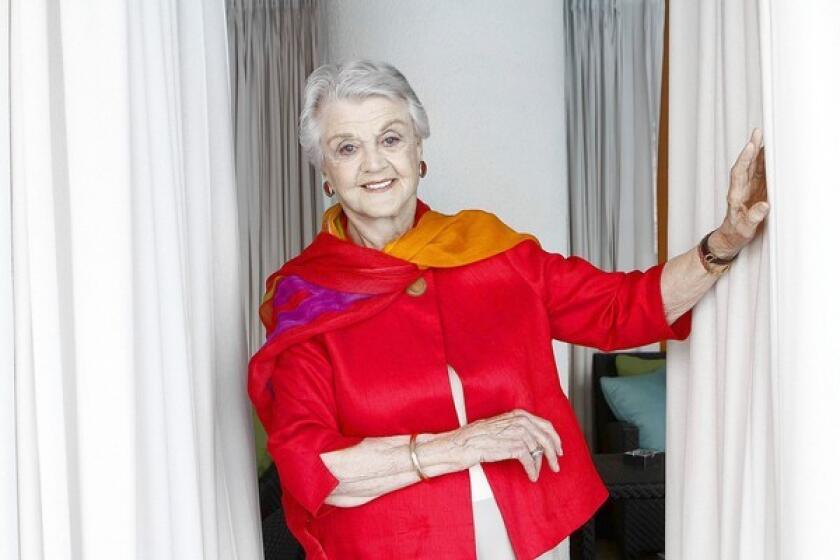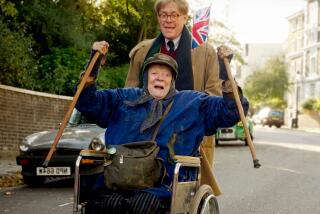Angela Lansbury, Broadway star and spunky detective in ‘Murder, She Wrote,’ dies at 96
- Share via
It was the classic but lighthearted whodunit “Murder, She Wrote” that rocketed Angela Lansbury to lasting television stardom, a literate and easy-to-track mystery show that made her and her impeccable manners welcome guests in living rooms across America.
But it was her deep roots in the theater and the many Tony Awards that followed that won the hearts of theatergoers and critics, who were often rhapsodic in their praise.
When “Mame” opened in Los Angeles in 1968 after a wildly successful run on Broadway, Lansbury received a 20-minute standing ovation. It was, theater director James Doolittle later said, “the most exciting opening” in Los Angeles theater history.
Never far from the stage she conquered with such authority, Lansbury died in her sleep Tuesday at her home in Los Angeles. She was 96. No cause was given.
“Murder, She Wrote” hovered near the top of the ratings for almost a decade, becoming a signature piece for CBS and making Lansbury a household name. Nominated for a dozen Emmys for playing the warm and spunky literary sleuth Jessica Fletcher, Lansbury never won but repeatedly said fans made her feel like a “national treasure.”
As gracious and unpretentious as her Brentwood home, Angela Lansbury radiated hospitality as she ushered me into her living room, where her honorary Oscar sits as casually as a figurine placed on a table while a kettle was whistling.
Although she considered the “Murder” mysteries “formula stuff,” Lansbury said the program had been popular because it was like a crossword puzzle the audience could solve along with her.
Even as a teenage contract player, Lansbury stood out. She was nominated for Academy Awards for her first two films: She played a maid in “Gaslight” (1944) and a music hall singer in “The Picture of Dorian Gray” (1945).
A third nomination came for her portrayal of the malevolent mother in “The Manchurian Candidate” (1962), which is often called her finest film performance. Lansbury once said she had “relished” acting so evil.
In 2013 she received an honorary Oscar at the Academy of Motion Picture Arts and Sciences’ Governors Awards.
After appearing in 36 movies and nearly as many teleplays, often portraying what she called “beastly women” much older than her age, superstardom came in middle age and a continent away.
At 40, Lansbury stormed the New York stage in 1966 as the zestful, eccentric star of “Mame,” a part she almost didn’t get because producers perceived her as “that lady who plays everybody’s mother.”
Critic Rex Reed declared that she brought “the Broadway stage about as close to an MGM musical as the Broadway stage is likely to get,” according to the 1996 biography “Angela Lansbury.”
She received her first Tony Award, for lead actress in a musical, and basked in the attention: “I want all the glamour there is,” Lansbury told Life magazine. “I’ve been starving for it.”
Her fourth Tony, in 1979, came for playing murderous Nellie Lovett in Stephen Sondheim’s deliciously ghoulish “Sweeney Todd.” Her performance is considered a classic of the musical theater.
At 83, she tied the record for most Tony Awards won for acting when she received a fifth for portraying a medium in the 2009 revival of “Blithe Spirit.” (Audra McDonald set a new record in 2014 when she won her sixth.) Lansbury reprised the role in 2014 when she returned to the stage.
Angela Lansbury, the star of stage and screen who died on Tuesday, put her talents at the service of story.
The Broadway years were “unbelievable,” Lansbury said, because she got to be everything she’d “never had the chance to be in the movies,” when MGM consistently cast her as “tough dames” that she didn’t enjoy playing.
The low point, she said, was portraying Elvis Presley’s mother in “Blue Hawaii” (1961) — when she was nine years older than the singer. Near the beginning of “Murder, She Wrote,” she was 59 but later said that viewers probably thought she was 85.
At about age 80, she played villainous Aunt Adelaide in the 2006 family film “Nanny McPhee.” By then, her voice was familiar to a generation that had grown up watching the 1991 Disney film “Beauty and the Beast” on video; Lansbury sings the title song and voices the motherly teapot.
Angela Brigid Lansbury was born Oct. 16, 1925, in London into a family used to playing to a crowd. Her mother, Moyna Macgill, was a noted Irish-born stage actress, and her grandfather George Lansbury led the British Labor Party in the early 1930s. Her maternal grandfather directed the Belfast Opera.
Her lumber-merchant father, Edgar Lansbury, died of cancer when she was 9.
From her mother’s first marriage, Lansbury had a half-sister, Isolde, who became the first wife of actor Peter Ustinov. She also had younger twin brothers, Edgar and Bruce, who grew up to be television producers. Bruce Lansbury died in 2017.
Her natural talent showed through what she called “family theatricals,” and she attended drama school in England and the U.S.
During World War II, the family fled by ship to America, arriving in New York in 1940.
For money, mother and daughter staged school readings of Shakespeare for $25 a performance. Lansbury also developed a musical comedy act that brought the 16-year-old her first steady work, at a Montreal nightclub.
Eventually, the women landed in Los Angeles and by 1942 were clerks at Bullock’s Wilshire. Her mother would have a minor Hollywood career and appeared with Lansbury in “Dorian Gray” and “Kind Lady” (1951).
An actor friend told her that MGM was looking for an English girl for “Dorian Gray.” Once on the lot, Lansbury met with director George Cukor, who was casting the role of the maid who flirts with Charles Boyer and menaces Ingrid Bergman in “Gaslight.”
When Louis B. Mayer saw her screen test, he said, “Sign that girl — she’s got talent,” Lansbury later recounted. She was given a seven-year contract.
MGM never saw her as a star, and from the beginning, her screen aura was that of a considerably older and often unpleasant woman. She portrayed Walter Pidgeon’s spiteful wife in “If Winter Comes” (1947) and Spencer Tracy’s mistress in “State of the Union” (1948).
In “National Velvet” (1944), she played Elizabeth Taylor’s older sister. Lansbury later recalled being hissed at in public because she was mean to Judy Garland in the 1946 musical “The Harvey Girls.”
Her first lead musical role was as the eccentric good witch in the 1971 musical “Bedknobs and Broomsticks.” The Disney film failed at the box office but, as usual, critics praised her performance. New Yorker critic Pauline Kael labeled Lansbury “a picture redeemer.”
A first marriage, at 19, to an actor 15 years her senior ended months after they wed, though they remained friends for life.
On a blind date, she met Peter Pullen Shaw, an actor so handsome he was said to have shown up at MGM with a contract. They married in 1949, and 30 years later Lansbury still referred to him as “lovely, lovely Peter.”
Frank Capra saw a screen test Lansbury did with Shaw and said, “The English guy is awful but I’m going to use her,” according to “Balancing Act,” a Lansbury biography. And he did, in 1948’s “State of the Union.”
This article was originally on a blog post platform and may be missing photos, graphics or links.
With Lansbury’s nudging, Shaw quit acting and became an agent for William Morris. His clients included Robert Mitchum and Katharine Hepburn.
The couple, who became U.S. citizens in 1951, lived in Encino and had a son, Anthony Peter, in 1952. Daughter Deirdre Angela arrived a year later. Shaw also had a son, David, from his first marriage. In addition to her three children, Lansbury is survived by three grandchildren, Peter, Katherine and Ian; five great-grandchildren; and her brother Edgar.
On Broadway, she debuted in 1957 with Bert Lahr in “Hotel Paradiso,” a French farce that made people see her as a legitimate actress, Lansbury later said. She also appeared with Joan Plowright in the 1960 Broadway hit “A Taste of Honey.”
The moment Lansbury said she had been waiting for came in 1963, when she received a letter from playwright Arthur Laurents, who wrote “West Side Story” and “Gypsy.”
He had penned the musical “Anyone Can Whistle” with Sondheim and wanted to know if she could sing. She played the part of the tough mayor in the offbeat fable that ran for only nine performances but brought her to the attention of Jerry Herman, composer and lyricist of “Hello, Dolly.” His next project was a musical version of the play “Auntie Mame.”
In 1966, Lansbury opened in New York in “Mame” and played the part for two years before appearing in traveling productions in Los Angeles and San Francisco.
Bea Arthur, who died in 2009, became a close friend after co-starring in “Mame.” She called Lansbury “a class act” who had “a mouth like a longshoreman,” Arthur told the Independent of London in 2003.
Again, Hollywood disappointed when it came time to make “Mame,” the movie. Lucille Ball got the part, and the film flopped.
Despite reaching a pinnacle onstage, Lansbury’s personal life began to fall apart. The Malibu home she called her “island in the sky” burned to the ground in a 1970 brush fire.
She also realized that the couple’s two younger children were experimenting with drugs and sought refuge in a former rectory in Ireland, “one of the last places on Earth that was fairly drug-free,” she later recalled.
For a decade, she and Shaw commuted to London and New York, and her son and daughter recovered from their addictions. Years later, she expressed guilt over having been away from home so much.
In 1973, Lansbury returned to the stage in a London revival of “Gypsy.” She followed the show to Broadway and earned a Tony. She also won a Tony for playing the tragicomic countess in the 1969 musical “Dear World.”
While in “Sweeney Todd,” Lansbury was approached about doing a television series about a bicycle-riding mystery writer in a Maine hamlet who solved real murders.
“Primarily I was motivated by ego,” Lansbury told the Saturday Evening Post about appearing on TV. “I wanted to play to that huge audience just once.”
She was also ready to settle down. The couple bought a Brentwood home, and she hunkered down to play America’s version of Miss Marple, solving 286 murders during the show’s 12-year run.
In 1987, her husband and his sons launched Corymore Productions, and over time Lansbury took a larger role overseeing the show. During the last four seasons, her brother Bruce was a supervising producer.
The show left her “perhaps richer than God and nearly as well liked,” the Washington Post said in 2000.
Her marriage to Shaw lasted 53 years, until his death at 84 in 2003.
The Tony Award winner reflects on the big charms of a little teapot, ‘Murder, She Wrote’ and life in New York and L.A.
In 2006, Lansbury rented a New York apartment, saying she needed to be near theater people again. The next year, she returned to Broadway in “Deuce” and was nominated for a Tony.
Returning to the stage “turned the tide for me,” she told the Associated Press in early 2013. “It gave me a career after 70. ... I loved the theater and, as it turned out, it was the thing to do.”
More to Read
The biggest entertainment stories
Get our big stories about Hollywood, film, television, music, arts, culture and more right in your inbox as soon as they publish.
You may occasionally receive promotional content from the Los Angeles Times.












